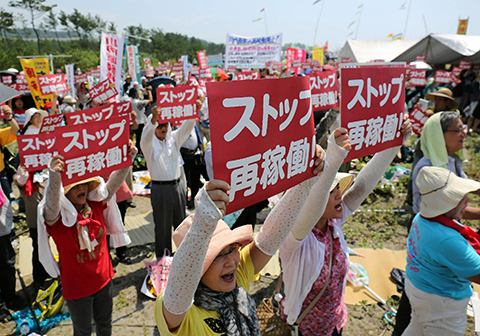TOKYO: A power plant operator said it will restart a reactor in southern Japan today, the first restart under new safety requirements following the Fukushima disaster and a milestone for the nation's return to nuclear power. Kyushu Electric Power Co. said Monday that it will restart the No. 1 reactor at its Sendai nuclear plant Tuesday morning.
The restart marks Japan's return to nuclear energy, breaking a four-and-half-year nuclear power impasse since the 2011 meltdowns at the Fukushima Dai-ichi nuclear power plant in northeastern Japan following an earthquake and tsunami. The disaster displaced more than 100,000 people due to radioactive contamination in the area.
The Nuclear Regulation Authority affirmed the safety of the Sendai reactor and another one at the plant last September under stricter safety rules imposed after the accident, the worst since the 1986 Chernobyl explosion. The plans call for the second reactor to be restarted in October.
The Sendai No. 1 reactor is scheduled to start generating power on Friday and reach full capacity next month. All of Japan's 43 operable reactors are currently offline. Of those, 23 others, including the other Sendai reactor, have applied for safety inspections and are in the process of restart approvals. Abe's government wants as many of them as possible to be put online to sustain the nation's economy, which now relies on imported energy.
"Our policy is to push forward restarts of reactors that cleared the world's toughest safety screening by the Nuclear Regulation Authority," Prime Minister Shinzo Abe told reporters yesterday. "I would like Kyushu Electric to put safety first and take utmost precautions for the restart."
Under a basic energy plan adopted by the Cabinet last year to sustain nuclear power as a key energy supply for resource-poor Japan, the government earlier this year set a goal for nuclear power to provide more than 20 percent of the country's energy needs by 2030.
Despite the push by the government and utilities for nuclear restarts, most Japanese are opposed to a return to nuclear energy. Residents near the Sendai plant are wary of the restarts, citing potential dangers from active volcanos in the region.
Cheap nuclear power
Yesterday, dozens of protesters, including Naoto Kan, prime minister at the time of the Fukushima crisis, rallied outside the Sendai plant in a last-ditch effort to stop the restart, shouting "We don't need nuclear plants."
The Fukushima disaster "exposed the myth of safe and cheap nuclear power, which turned out to be dangerous and expensive. Why are we trying to resume nuclear power?" Kan told the crowd.
Opponents of the restarts and nuclear experts are also concerned that evacuation plans, in case of disasters, may not work well. Experts also are concerned about possible glitches in mothballed reactors that have not been used for more than four years.
With its nuclear fuel recycling program stalled and plutonium stockpiles triggering international concerns, Japan is under pressure to use as much of its stockpiles as possible in its reactors.
US Undersecretary of State for Arms Control and International Security Rose Gottemoeller told journalists in a teleconference that Japan should complete its pending fuel recycling program and burn plutonium as a fuel called MOX at reactors.
"If there is going to be a plutonium program, reprocessing program, the flip side of it is that there has to be a very vigorous MOX program and that the MOX actually has to be burned in power plants," Gottemoeller said.
Japan has more than 40 tons of weapons-grade plutonium, enough to make 40 to 50 nuclear weapons. The question is whether Japan can restart as many as 18 reactors needed to burn enough plutonium, and whether the problem-plagued Rokkasho reprocessing plant in northern Japan starts up. - AP



